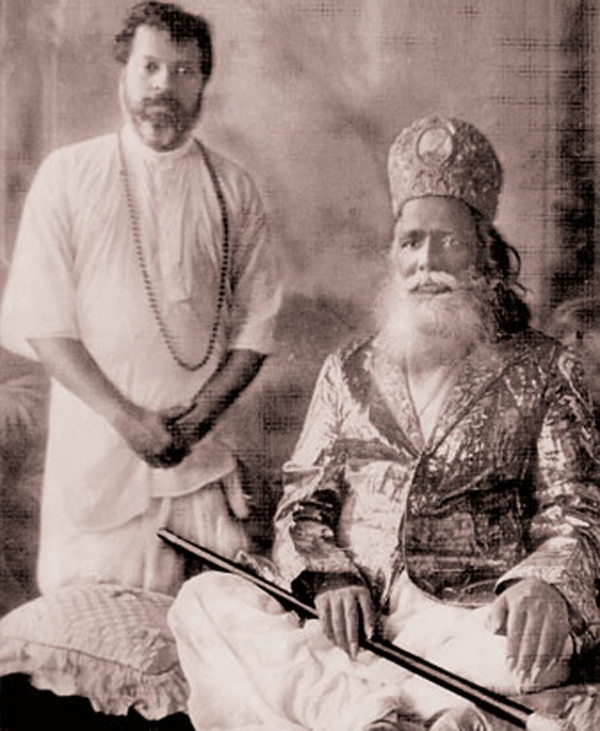
Pandit Vishnu Digambar Paluskar with Shreeji | Bombay 1919
The metallic brakes of the steam engine squealed and the chimney huffed smoke into the Bombay sky as the Madras Mail, the only train connecting the city to the southern part of the country announced its arrival at the Victoria Terminus station with a loud shrieky whistle. It was 1919, Shri Martand Manik Prabhu Maharaj’s first visit to the port city.
Bombay (now Mumbai) was not only the foremost trading centre of British Presidency, but was also a thriving hub of art, music and culture.
When Pandit Vishnu Digambar Paluskar – the doyen of Hindustani Classical Music learnt that Shreeji was in town on an official visit, he invited Shreeji to the Sandhurst Road branch of the Gandharva Maha Vidyalaya that he had recently launched. A great patron of music that he was, Shreeji not only obliged, but, on his insistence, also agreed to stay at the Vidyalaya for a few days, during which stalwarts like Ustad Rehmat Khan Saheb, Ustad Abdul Kareem Khan, Pandit Bhaskarbuwa Bakhale and Vidhushi Kesarbai Kerkar performed in hazri before him and sought his blessings.
Musicians lined up for Shreeji’s darshan, waiting for an opportunity to perform in front of him. Among the regular visitors was Narayan Shripad Rajhans, popularly known by the stage name ‘Balgandharva’, whose music was greatly liked and appreciated by Shreeji. It is said when Balgandharva performed, everyone, including Shreeji, would lose sense of time and the sabha most of the time would continue until the wee hours.
On the concluding day of Shreeji’s stay at the Maha-Vidyalaya, Pandit Vishnu Digambar Paluskar offered Sangeet Seva and his performance impressed Shreeji so much that he placed a garland of flowers around Panditji’s neck.
Overwhelmed by Shreeji’s appreciation, Pandit Paluskar, in his thanksgiving speech said that he considered the garland of flowers received from Shreeji as valuable as a navaratna haar (a garland of gems). Interrupting him midway, Shreeji called him and placed his own navaratna haar around Panditji’s neck.
“Why consider a garland of flowers as a navaratna haar? Instead, wear one.”
This great gesture from Shreeji moved Pandit Paluskar to tears. He was speechless and did not know how to thank Shreeji.
Very few know that the navaratna haar which Shreeji presented to Pandit Paluskar had actually been gifted to him by Jagadguru Shri Narsimha Bharati Swamiji ji – Shankaracharya of the Shringeri Sharada Peetham, as prasaad, when he visited Maniknagar during Shri Sadguru Manik Prabhu Maharaj’s era. When both the brothers – Manohar Prabhu and Martand Prabhu, who were very young then, were respectfully presented by Shri Prabhu himself before the Acharya for his blessings, the Acharya most thoughtfully gifted a rudrakhsa maalaa to Shri Manohar Prabhu and a navartana haar (a necklace of gems) to the younger brother – Martand Prabhu. This probably was Jagadguru’s way of appreciating the inherent yogic vairagya (dispassion) of the young Manohar Manik Prabhu and the sparkle of spiritual majesty that he saw in his three-year-old brother, Martand Manik Prabhu.
It is not without reason that Maniknagar is truly called the “The Mecca of Music”, where musicians receive rare honour. Music is the second name for the Divine at Maniknagar.
[social_warfare]
Very well written. The visit of Shri Martand Manikprabhu to Mumbai in 1919 was indeed a blessing for Mumbai devotees. Many families got associated with Samsthan thereafter and have continued to avail blessings till date. Feeling truely blessed. Jai Guru Manik
Congratulations Charudatt Prabhu for highlighting the importance of music in Shri Prabhu Samsthan’s history. The legacy is still carried on till date ! Jai Guru Manik !
Very nice story
Music is in every breath at maniknagar,were even birds and animals enjoy the nature by singing.
यह हमारा सौभाग्य है कि हम प्रभु भक्त भक्ति के मार्ग द्वारा माणिक नगर तीर्थ स्थल से जुड़ें हुए हैं। जय गुरु माणिक।
धन्यवाद चारुदत्त प्रभु| बहुत ही बढिया जानकारी दी है|धन्यवाद|
पं. विष्णु दिगंबर पलुस्कर : वह कलाकार जिसकी बदौलत भारत का शास्त्रीय संगीत दुनियाभर में मान पा सका
महात्मा गांधी के प्रिय भजन ‘रघुपति राघव राजाराम…’ के पहले कंपोज़र और मौलिक गायक विष्णु दिगंबर पलुस्कर ही थे.
????????||श्री_माणिक्यप्रभोर्विजयते||????????
खुप चांगली माहिती मिळाली आम्ही सगळे मुंबईचे भक्तगण नशीबवान आहोत
जय श्री गुरू माणिक
फारच छान माहिती , सदगुरु मार्तण्ड मणिकप्रभुनचा मोठेपणा आणि औदार्य ,कला वंतांचा सत्कार उचित तर्हेने करण ह्या गोष्टी दिसतात
सदगुरु मार्तण्ड माणिक प्रभुना सा . नमस्कार
स्वत: प्रभुच म्हणाले होते की तो ५६ संस्थान उभे करील त्याला काही म्हणू नका मार्तंड प्रभुंचया औदार्य चे बाबतीत sky is the limit असे म्हटले जाते त्या मुळे अशी उदाहरणे पावलोपावली आढळतात वारसा उगाच समृद्ध होत नाही हाच संदेश आपणास मिळतो.
जय गुरु माणिक
Jai guru manik, please continue to publish such remarkable spiritual articles. We are thankful to you.
Thank you, Charudatt Prabhu ,for recounting this “Gem” of an incident from a Century ago. Very enlightening, indeed.
Shree Martand Manik Prabhu Maharaj literally laid the foundation of Shree Manik Prabhu Saunsthan’s renown as a Mecca for Musicians. It is no wonder that Musicians and Singers from Bharat Ratna Bhimsen Joshi, Pandit Shiv Kumar Sharma, Pandit Hari Prasad Chaurasia, Ustad Allah Rakha, Ustad Zakir Hussain to Vidushi Kaushiki Chakraborty have all rendered Seva to Shree Manik Prabhu Maharaj by performing in Manik Nagar. Musicians and Singers crave for appreciation more than anything else and Shree Manik Prabhu Maharaj and His Successors have all had a keen ear for music.
It’s such heart touching incident which reflects the hospitality of Pt.Paluskar and generosity of Shree Martand Manik prabhu maharaj.And his love towards music.
Thanks for sharing such a information.
Looking forward for ,such a historical write up
Jai Guru Manik
????????????????
Very important information Jai guru manik
Dear Charu
Fantastic style. Keep writing. I know what you are capable of — some rich prose in times to come. Please keep writing ????????